Ming Tombs - Eunuch Tian Yi
Loyal Tenure
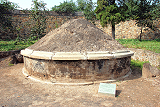 Click here to see more photos from Ming eunuch Tian Yi's mausoleum
Click here to see more photos from Ming eunuch Tian Yi's mausoleumEunuch Tian Yi (1534 - 1605) served three consecutive Ming emperors. He was born in Shaanxi Province and, having been castrated at the age of nine, commenced his tenure in the Beijing Imperial Palace, today's "Forbidden City", under the Jiajing Emperor (1522 - 1566).
He remained a loyal palace servant during the reign of the subsequent Longqing Emperor (1567 - 1572) and during the first part of the reign of his successor, the Wanli Emperor (1573 - 1620).

Because of his diligence, prudence and experience he rose through the ranks all the way to a top position overseeing the most important of the twelve eunuch directorates, the Directorate of Ceremonies.
He fell ill in his palace quarters in 1583, but even the most learned doctors of the royal palace could not heal him and he eventually passed away in 1605, 72 years old.
The Wanli Emperor was so deeply saddened to learn of Tian Yi's death that he mourned for three days, completely suspending all court sessions.
A Good Eunuch
Tian Yi was an excellent example of all that a good eunuch was supposed to be.

He never engaged in court politics and remained impartial in the many internal court intrigues of which there were many during his tenure in the imperial palace.
He remained upright and loyal to his Emperor and despite his high office he never sided with any of the many court factions jockeying for power.
The Emperors he served had full trust in him and confidence in his neutrality. On the few occasions when Tian Yi expressed an opinion on a state matter, the Emperor accepted it as factual and unbiased.
Even when he was critical of a policy, the Emperor would allow the dissent, because the Emperor was confident that Tian Yi intended no subtle, personal or political gain and that he would only be speaking his own personal mind and not that prompted by other, more sinister minded court attendants.
Longevity reward

Tian Yi was post humanly rewarded for his faithfulness. The Wanli Emperor made an exception and had a special mausoleum prepared for Tian Yi, paid for by the state coffers.
Most other eunuchs were either interred back at their family grave site or in one of two mausoleums located in Beijing's western hills and designated for palace eunuchs.
The former tombs were mostly looted and demolished shortly after the eunuch's body had been buried. Of the latter two designated ones in Beijing's suburbs, one (Biyunsi) was deliberately destroyed on the instructions of the Qing Qianlong Emperor (r. 1735 – 96), and the other (West Mountain Eunuch Tombs) was ravaged many times and eventually demolished.
Thus, the memory of Tian Yi's dedicated service and good personality has endured and his crypt is now the only eunuch tomb one left fairly intact in the Chinese capital.

Tian Yi Ling layout
(1) Tian Yi's tomb mound
(2) Other eunuch tombs
(3) Chamber entrance
(4) Memorial steles
(5) Sacrificial altars
(6) Ceremonial vessels
(7) Vase
(8) Graveyard gate
(9) Ancestral temple
(10) Pavilions
(11) Lingxingmen gate
(12) Military official
(13) Civil official
(14) Eunuch museum
(15) Huabao column
(16) Sacred Way gate
(17) Storage area
Versatility
Eunuch Tian Yi's tomb was constructed in the early 17th century some 15 kilometers west of central Beijing, in the western hills.
At some time during the remaining part of the Ming dynasty (1368 - 1644) Tian Yi's mausoleum was incorporated into Cixiang Nunnery, established at the same location.
In the subsequent Qing dynasty (1644 - 1911) many palace eunuchs, who were ousted from the Palace as being too old or frail to be of any further usefulness, took up residence as monks in the nunnery, guarding and tending to Tian Yi's mausoleum. Such good care paired with generous financial support from serving eunuchs added to the preservation of Tian Yi's tomb.
 The stone carvings in Tian Yi's mausoleum are among the technically finest of the times. Click here for a gallery demonstrating more of the superb craftsmanship found here.
The stone carvings in Tian Yi's mausoleum are among the technically finest of the times. Click here for a gallery demonstrating more of the superb craftsmanship found here.Four of the eunuchs, who lived here as monks, were interred inside the mausoleum proper; two east and two west of Tian Yi's center crypt. All five tomb mounds are still extant (numbered 1 and 2 on the layout left).
The tomb suffered badly during the time of the Republic of China (1912 - 1949). Many warlords looted the tomb in search of treasure, which could finance their military quest. Fortunately, the overall tomb and crypt as well as Tian Yi's earthly remains were left mostly intact.
In the 1950's the mausoleum had the luck of being encapsulated in a kindergarten. Why "luck"? To protect the children the back of the tomb was sealed off, which, as an unintended but welcomed consequence, meant that the tomb survived the later chaotic time of the Cultural Revolution, during which innumerous archaeological sites were rampaged or outright demolished.

Gate of the Sacred Way
Finally, in 1998 the national cultural heritage administration took over the site and constructed the first (and only?) eunuch museum at the front. The museum opened already same year and has since undergone renovations, latest in 2008.
The front gate (16)
The layout follows the traditional scheme with a center "sacred way" from front to back, and a clear division between the front section, used by the living for visits to pay tribute to the deceased, and the rear section, which was always closed off and considered part of the "netherworld".
Numbers refer to the layout model left of this section.
The mausoleum has three gates. The outer one, Gate of the Sacred Way, greets the visitor and steers him on to the center path.
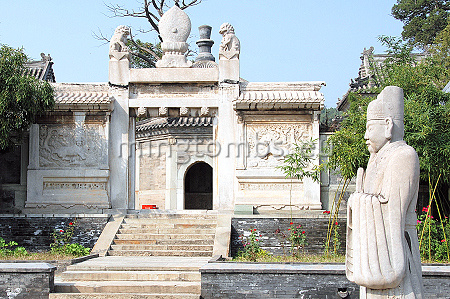
Lingxingmen gate with a civil official in front.
The seemingly inconspicuous gate is adorned with fine masonry details in the figures below the crossbar as well as the lining of the characters. The characters state the name of the eunuch tomb.
To the right of this gate lies the eunuch museum (14) and further right is a storage area (17) for various artifacts from other eunuch tombs.
Lingxingmen (11)
Just beyond the front gate the Sacred Way traverses a small yard on its way to the entrance gate to the tomb proper, Lingxingmen.

Ornamental column
Huabiao
The access to the gate is guarded by a figure on each side of the Sacred Way. On the left is a military official (12) and on the right a civil official (13). The figures are carved in marble and not stone, since stone in ancient China was considered lifeless.
A little further east, but still inside the small yard, is a single ornamental column (15), or 'huabiao'. In Chinese dynastic times, these would normally be found in pairs, two in front of a gate and two behind.
Two small levels higher up, Lingxingmen gate rises majestically. This double pillar gate was used in most imperial tombs, however not at the front as in this mausoleum, but far further to the rear, just before the five vessels and memorial tablet building.

Lion decoration on the southern side
of Lingxingmen gate
Lingxingmen gate at Tian Yi's tomb also differs by having side panels with animal motifs. On the outside (south) there are lions in a forest and on the inside there are deer roaming in a forest.
The traditional griff-like legendary animal ("wangtianhou") adorn the top of each pillar and a carving of a flaming pearl decorates the bar over the central entrance. The flaming pearl symbol can also be found on the Sacred Way in Shisanling.

- Center, octagonal pavilion -
It contains the Wanli Emperor's appointment of Tian Yi
The Pavilions (10)
The next section holds three pavilions. The central one is octagonal in shape and the other two have a square footprint.
The central pavilion contains a stele depicting the Wanli Emperor's edict of eunuch Tian Yi's official appointment as overseeing the Directorate of Ceremonies, a powerful and prestigious position in the eunuch administration of the Ming dynasty.
The front and back side of the stele base carries a beautiful carving of three dancing dragons. The other two sides boast a lion in a landscape. The carvings are still crisp these odd 400 years later and flowers, berries, leaves, grass and even the lion's whiskers are in perfect condition and worth a visit.
The western pavilion contains a stele, which describes Tian Yi's life story. The stele base is decorated with two dragons playing with a pearl on the two wider sides and a single dragon on the narrow sides.
The stele inside the eastern pavilion is inscribed with the Wanli Emperor's (1573 - 1620) edict of the professional achievements during Tian Yi's official assignments. The font size on this stele is smaller than that on the stele in the western pavilion.

Xian De, or ancestral temple hall.
Main Hall (9)
Behind the three pavilions lie the ancestral temple hall, "Xian De".
All wooden structures have long since perished and only the plinths, which were at the base of the wooden columns, give an idea of the location of the roof and the size of the original hall.
The rectangular shaped hall had entrances in south and north with a stone base flooring. A few pieces of stone walls gives an impression of what once was.
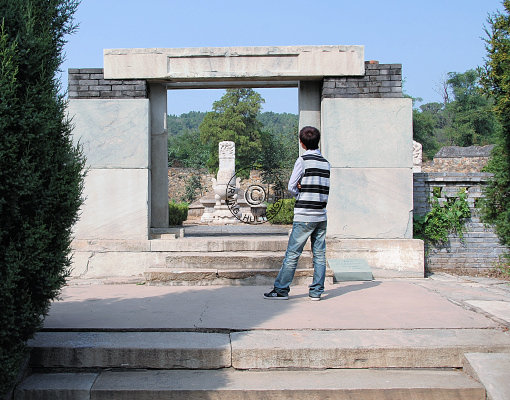
Shouyimen -Entrance to the graveyard
The temple contains five steles, one in the center of the hall and two pairs on each side of the back exit against the (no longer extant) back wall. The stele in the center carries the name of eunuch Tian Yi. The other four carry the names of the eunuchs, who are also buried inside Tian Yi's mausoleum.
Shouyimen -Graveyard Gate (8)
A few meters behind the ancestral temple lies the gate to the graveyard. The gate demarcates the boundary between the area for the living and the area for the deceased. Normally, nobody would pass through this gate after the burial of the dead.
The gate is quite dilapidated and has undergone significant restoration. Only few pieces of the original gate remains -the inscribed top crossbar being one of them.
The original doors have perished.

Graveyard area -Tian Yi's tomb mound rear center
Graveyard site
Past the gate, the Sacred Way is flanked by grassy areas on both sides until it ends at the burial site.
The burial site has three main sections. The front section has several sets of ceremonial marble vessel and sacrificial altars. Behind them is a section with steles and the tomb mounds of the four eunuchs, who were interred in Tian Yi's mausoleum. Finally, in the rear center is the original tomb of Tian Yi.
The back wall of the mausoleum forms a semicircle.
The Ceremonial Vessels (6)
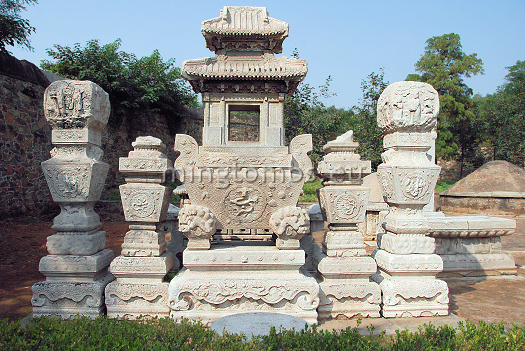
- Exquisitely decorated ceremonial marble vessels -
Incense urn in centre, flanked by candle holders and vases
The mausoleum boasts not one, but two complete sets of ceremonial vessels. Moreover, the vessels are of high quality and of a highly ornamented type normally only found in tombs from the Qing dynasty.
The only other Ming tomb with similarly decorated vessels is Siling, the final resting place of the Chongzhen Emperor (1627 - 1644), the last ruler of the Ming dynasty (1368 - 1644).
It is unclear -and far from certain- if these vessels were brought here from another mausoleum, or if they were placed here originally in 1605.

Sacrificial Altar
Sacrificial Altars (5)
Surprisingly, Tian Yi's mausoleum contains six sacrificial altars. The only altar, which could normally be found in imperial Ming tombs, is the one on which the ceremonial vessels were placed.
Again, some of these altars have probably been brought here from other grave sites.
The altars have rich engravings on the sides and base; typically swirling clouds (see photo), flowers, plants and other symmetric symbols. Some even have cooking utensils and vegetables, but not the ones in Tian Yi mausoleum.
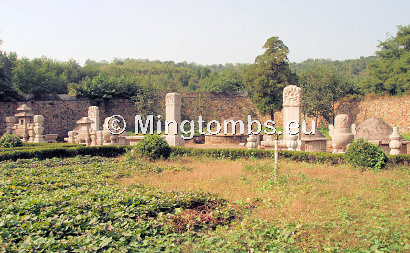
- Three steles -
note the square one in the centre
A sacrificial altar can also be found in one of the Ming dynasty concubine tombs.
Steles (4)
Behind the altars and ceremonial vessels are the four tombs of eunuchs buried within Tian Yi's mausoleum, but at a later time.
Also in this section are three steles. The center one -in front of Tian Yi's tomb mound- is unusual because all four sides are of the same size instead of the traditional front and back "flat" type.
Four Eunuch Tombs (2)
Four of the eunuchs, who -after having served the palace- joined the nunnery at this location and took care of Tian Yi's tomb, were later interred here as a special honor. Two are placed east of Tian Yi's crypt and two are placed west.
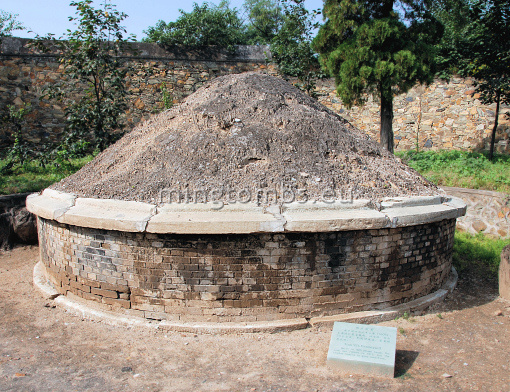
Tian Yi's tomb mound
Two of the tomb mounds are octagonal in shape and two are circular. All of them (but not that of Tian Yi) have well preserved marble relief sculptures around their base depicting tales from ancient times.
Tian Yi's Crypt (1)
The tomb was opened and looted on several occasions back in the early days of the Republic of China (1911 - 1949), however Tian Yi's earthly remains were fortunately left in place.
The tomb mound is circular in shape, reinforced around the base with brick and capped with a dilapidated cone. The base carries no decorations.

- Burial chamber -
Entrance in rear
grave in lower front
One enters the chamber through a concrete staircase (3). Inside the dark, underground chamber is the grave, a stone plate with his name inscribed and some timber.
The burial chamber has "window" niches on three walls. Two decorated stone doors fill the center of the fourth wall.
It is an eerie feeling to stand inside the chamber. But the darkness and quietness also instill awe and respect for the deceased and his accomplishments, which must have been exceptional to have an emperor use so many resources on a humble eunuch's tomb.
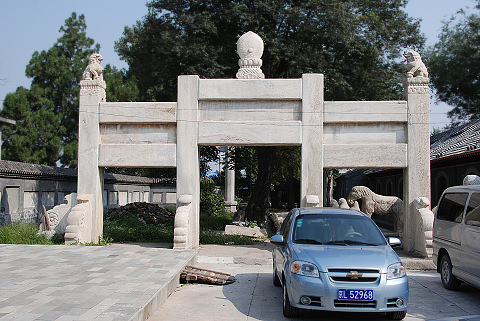
Entrance to relic storage area
The Eunuch Museum
In the front section of the mausoleum is a building housing China's (only?) eunuch museum (14).
Unfortunately, all the displays are explained in Chinese only despite the interesting fact, that most visitors are foreigners.
But if you would like to know more about the museum you are highly recommended to visit Mary King's informative article on Tian Yi Ling.
Storage (17)
No, this is not advice on where you can store your belongings while you stroll around the mausoleum.
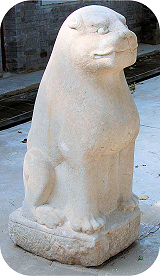
Unfinished
mythical beast
As mentioned earlier, almost all eunuch Ming tombs have been demolished. But many relics from these tombs have survived pillaging and some of these pieces have found their way to Tian Yi's mausoleum.
Just inside and to the right of the entrance is a small area set aside for storage of ancient marble and stone relics. You cannot miss it since the entrance is a large marble pailou (see photo above).
There are many interesting pieces to study. Left of here is for instance an unfinished sculpture of a mythical beast.
But there are also horses, vases, a torso, a huabiao and many many more.